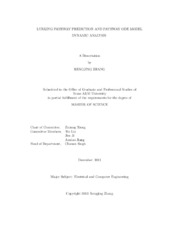| dc.description.abstract | Signaling pathway analysis is so important to study the causes of diseases and
the treatment of drugs. Finding the lurking pathway from ligand to signature is a significant issue
in studying the mechanism of how the cell response to the stimulation signal. However, recent
literature based pathway analysis methods can only tell about highly differentially expressed
pathways related to the experiment data, which may tell nothing about our interested specific
ligand and signature.
In this paper, we designed an approach to successfully detect the most reliable pathways for
specific ligand and signature by solving multi-objective optimization problem on the bridge
connecting two signaling pathways where the ligand and sig- nature locate. The pathway bridge
consisted of enriched looping patterns refined the complicated entire protein interactions network
with 39031 links, which made the approach time-saving. The approach was further applied to study
the mod- ulator mechanism of the signal molecule, receptor, intermediate transfer proteins,
transcription factor, and signature.
With preliminary studied pathways, we then employed Ordinary Differential Equations(ODE) to
modeling and dynamic analysis the signaling transduction. The biological reactions were
represented in terms of differential equations, and the solu- tions to the group of equations were
further be optimized to fit the RPPA experiment data. In order to find the potential signaling
paths in specific disease and discovery the best therapy, coefficient variation analysis, system
robustness study and system outcomes changes to perturbations were also utilized.
Our approach successfully predicted the lurking pathway for the signal molecule T GF β1 and the nova protein OC I AD2 in cancer microenviroment: T GF β1 −T GF βR1 − SM AD2/3 − SM AD4/AR − OC I AD2, and this result was verified by literature. Better than recent pathway analysis tool, our predicted pathway also took care of significant but relatively less regulated proteins in the transduction pro- cess. And by modeling the CCL2 pathway in MTB infected cells, J N K , cM Y C and P LC showed as the most significant modules. Hence, the drug treatments inhibit- ing J N K , cM Y C and P LC would effectively obstruct the increasing of MMPs and further prevent the Mtb infections. | en |


